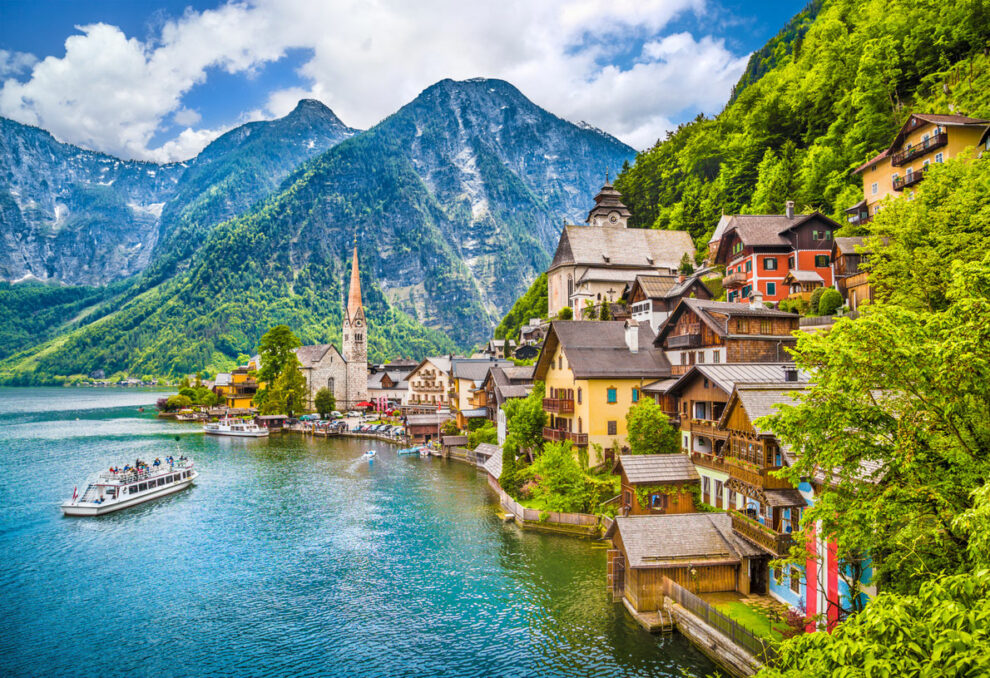If you’re overwhelmed while planning for a European vacation, you’re not alone. There are so many popular destinations worth visiting that it can be difficult to pare down a list to chose from. How do you sort out which cities are too expensive, too crowded, or have the type of attractions you’re looking for?
Read on for an in-depth look at five European cities you might want to include in your travel itinerary and check out our quick travel guide to help you plan the perfect European vacation.
Our Top Picks for Best Places to Visit in Europe
- Dublin, Ireland – Best tourist attractions
- Barcelona, Spain – Best theme parks
- Gdansk, Poland – Best historical destination
- Prague, Czech Republic – Best architecture
- Chania, Greece – Best beaches
Best Places to Visit in Europe Reviews
Best Tourist Attractions in Europe: Dublin, Ireland
PROS
- Free parks and hiking areas
- Accessible from other Western European destinations
CONS
- Inclement weather during off-season
Why we chose it: Dublin, Ireland is full of entertaining tourist attractions including castles, museums, free parks, historical sites and plenty of nightlife.
Dublin offers attractions to visitors of all stripes. Its well-maintained historical sites dating back to medieval times attract history buffs; its nightlife, whiskey and plentiful pubs make it a reveler’s delight, while its free parks and natural scenery make it an agreeable place for the whole family.
A few of Dublin’s most popular tourist attractions are:
- Trinity College Dublin: One of the oldest universities in Europe, with beautiful stone architecture and classical buildings. Several guided tours are available for a fee.
- National Botanic Gardens: World-renowned botanical gardens in the heart of Dublin. Entrance is free.
- Temple Bar: A popular nightlife district, centered around the famous Temple Bar Pub.
- Dublin Castle: A medieval castle that currently serves as a government complex. Tour costs vary by season.
- Phoenix Park: One of the largest enclosed public parks in Europe, free to visit.
On top of the attractions within Dublin’s city limits, you can also visit the castles, national parks, charming towns and beaches dotted throughout Ireland by renting a car or taking public transportation. Another advantage is that the city is highly accessible from other destinations — you’ll find affordable flights to Dublin from most major European cities.
Dublin can get crowded during the summer months and around the winter holidays. Prices for museums and tours also tend to increase during those months, so you’ll save money by traveling to Dublin in the off-season. Unfortunately, those winter months are when the weather can get unpleasant, blustery and rainy.
Despite the rain and cold, Dublin is an entertaining and accessible city to add to your itinerary as you explore Europe.
Best Theme Parks in Europe: Barcelona, Spain
PROS
- Sunny weather
- Good public transportation system
CONS
- Pricier than other destinations
Why we chose it: Barcelona has multiple amusement parks including the famous Tibidabo Amusement Park, one of the oldest theme parks in the world.
Barcelona, Spain is a bustling cultural center in Europe with plenty of attractions, including ancient architecture and world-class food. But the city’s whimsical side is also displayed in its variety of theme parks, water parks and rides.
Tibidabo Amusement Park is the oldest amusement park in Spain (and one of the oldest in the world). It’s situated on Tibidabo — the tallest hill in the area — with views of the surrounding city and ocean below. While there, you can ride the Ferris wheel and roller coaster or enjoy seasonal entertainment around Halloween and Christmas. Tickets cost €35 with the train ride up Tibidabo or €14 separately.
PortAventura Park, located about an hour outside of Barcelona, is another popular amusement park with rides, shows, restaurants and bars. It offers three hotel complexes, with one located inside the park — a fun option if you’re traveling with kids. Ticket costs vary by season but you can save money by buying them online before your trip.
Aside from theme parks, you’ll also find plenty of public parks, green spaces and sunny beaches in Barcelona. You should also be aware that, as part of the autonomous community of Catalunya, Barcelona stands out from the rest of Spain — residents speak Catalan as well as Spanish, the cuisine is unique to the region and prices are higher than in other smaller Spanish cities.
Best Historical Place in Europe: Gdansk, Poland
PROS
- Affordable destination
- Lively street markets
CONS
- Relatively cold, even in the summer
Why we chose it: In Gdansk, you can visit historical sites relevant to maritime history, World War II, the Solidarity movement and even medieval times.
Gdansk, Poland is a port city and historical merchant town on the northern coast of Poland. Although much of the city was destroyed during the Second World War, it has been rebuilt to match its original charm. The city’s Old Town maintains its Renaissance-style architecture, colorful buildings and street markets.
Along with Old Town, you can also visit Gdank’s many museums to learn about local history, including:
- Museum of the Second World War: Here, you’ll learn about the events of World War II from the perspective of Polish citizens.
- Museum of Gdansk: A Gothic/Renaissance-style building with modern and local art.
- Museum of Amber: Learn about the amber trade and its role in making Gdansk a thriving merchant town.
- Europejskie Centrum Solidarności: Roughly translated as the “European Center of Solidarity”, the museum is devoted to the history of Solidarity movement during Soviet rule in Poland.
Ticket costs to Gdansk’s museums vary by season but are generally less than $10 per person. Poland is one of the cheapest places to travel in Europe and has its own currency — you’ll pay less for attractions, food and lodging in Gdansk than in bigger cities like London, Berlin or Barcelona. However, that means you’ll have to exchange currency when you get there.
The weather also rarely gets warm, with average highs of only 63 degrees Fahrenheit in the summer. You also might encounter a language barrier in Gdansk as English isn’t as prevalent as in other major cities.
Best Architecture in Europe: Prague, Czech Republic
PROS
- Renowned Christmas markets
- Historical old town
CONS
- Cold and dark in the winter months
Why we chose it: Prague, Czech Republic is one of the few major Central European cities to make it through the 20th century with their historic architecture mostly intact, including its stunning Gothic and Romanesque buildings.
If you’re a fan of Gothic architecture, you’ll love walking the streets of Prague. The city’s Old Town is well-preserved from medieval times, with cobbled streets, winding alleyways and tall spires. Prague has an extensive and efficient public transportation system, so you can quickly get around the city without a rental car or taxi.
Some of Prague’s most notable architectural sites include:
- Charles Bridge: A medieval stone bridge spanning the Vltava River flanked by religious statues.
- Old Town Hall: Prague’s ancient city center with one of the oldest astronomical clocks in the world.
- Church of Our Lady Before Týn: An 11th-century Gothic-style church, open to public visitors.
- Schwarzenberg Palace: A Renaissance-era palace and current museum with Czech Baroque paintings.
There is no charge to walk around some of Prague’s most famous historical sites and take in the architecture, but you can pay for a guided walking tour to learn more about the history behind each building.
As beautiful as it is, Prague is also a very old city — you can see the impact of decades of pollution on the buildings, and the ancient, narrow alleyways can collect some litter. Prague can also be very cold in the winter months, making walking around and viewing the architecture less enjoyable.
Prague is more affordable than some Western European cities, so it’s a good destination if you want to visit Europe on a budget, even during the pricier summer months.
Best Beach in Europe: Chania, Greece
PROS
- Off the beaten path (compared to other destinations in Greece)
- Sunny weather even in the off-season
CONS
- Small streets can get crowded
Why we chose it: If you want to visit Greece’s crystal clear beaches without the crowds and high costs of other beach resort towns, try Chania, a harbor city on the island of Crete that offers beach weather even in late fall.
Chania, Greece — the second-largest city on the island of Crete — offers warm, sunny climate and hidden bays, making it a great destination if you’re looking for the best beaches in Europe. Unlike Mykonos and other popular Greek beach communities, Chania is off the beaten path for most tourists. Pleasant weather extends until late November, so you can beat the crowds and still enjoy plenty of warmth and sunshine.
While Chania itself is a port town with cobbled streets and wooden docks, there are plenty of sandy beaches within a short drive or boat ride from the city. The most popular beaches include:
- Elafonisi Beach: A white-sand islet, easiest to reach by boat.
- Balos Beach: A secluded beach accessible by road or boat.
- Falassarna Beach: A family-friendly resort area with a long, sandy beach surrounded by olive groves.
Chania offers affordable accommodations, diverse food options — including Jewish, Turkish and Middle Eastern cuisines — and fresh seafood. There is some nightlife, but the town is quieter than other destinations in Greece. You should also be aware that Chania doesn’t have the whitewashed, domed buildings or high cliffs other Greek towns are known for.
Other Places to Visit in Europe We Considered
Utrecht, Netherlands
PROS
- Less crowded alternative to Amsterdam
- Close to the Amsterdam airport
CONS
- Can be expensive
Utrecht, Netherlands has the cafés and canals of Amsterdam, minus the crowds and higher prices. It’s a quick train ride from Amsterdam Airport Schiphol and can be a stop on your Netherlands trip or a destination of its own. Although it isn’t quite as pricey as Amsterdam, the cost of food and lodging in Utrecht is still relatively high compared to other European cities.
Lisbon, Portugal
PROS
- Colorful architecture
- Great food options
CONS
- Crowded year-round
Lisbon, Portugal is one of Western Europe’s most popular tourist destinations. It is generally considered to have a laid-back vibe with charming cobbled streets, colorful buildings and spectacular coastal views. However, because it’s so popular, this city is crowded with tourists year-round.
Reykjavik, Iceland
PROS
- Abundance of natural wonders
- Vibrant nightlife
CONS
- Far from the rest of Europe
Reykjavik, Iceland is home to natural wonders like waterfalls, glaciers, volcanoes and even the Aurora Borealis. This is a great destination for nature-lovers but, if you’re planning on visiting multiple European cities on your trip, it might be challenging to work Iceland into your itinerary due to its distance from other European countries. Reykjavik might be best for a single-destination trip.
Places to Visit in Europe Guide
If you’re looking for the best international places to travel, you’ll find no shortage of bucket list destinations in Europe. Although it’s difficult to definitively rank the best cities to visit in Europe — or even the best countries to visit in Europe — we’ve compiled this quick European travel guide to help you plan your trip. Remember that the ideal destinations will depend on your priorities and when you’re traveling.
The basics of Europe
Before you start comparing the best airlines or best hotels for your trip, you’ll want to establish your priorities. It’s impossible to see every tourist destination in one trip but focusing on what you want to do and what your ultimate goals are for your trip.
Here are some things to consider to help you decide which European destination works best for your trip.
Regions
Europe has distinct regions based on culture, geography and language. The main generalized geographical areas of Europe are:
- Western Europe – This is where you’ll find some of the most popular European destinations including France, the Netherlands and the United Kingdom. These countries are often expensive to visit and can get cold in winter, but they also contain several global cities and important historical sites.
- Southern Europe – Spain, Italy and Portugal are all Southern European countries with typically sunny climates, Mediterranean cuisine and historic architecture.
- Central Europe – When visiting Germany, Poland or the Czech Republic you’ll find colder climates, as well as cultural and historic attractions.
- Eastern Europe – Estonia, Georgia and Croatia are examples of Eastern European destinations you might not have considered traveling to but that offer unique cultural experiences at an affordable cost.
Weather
Depending on the time of year you’re traveling, weather can make or break your trip. Western and Central European countries experience dark, freezing winters, making sightseeing challenging.
Cultures
Despite being a relatively small geographical area, Europe contains hundreds of diverse cultures. You should expect different cultural norms regarding dining, public transportation and conversations everywhere you go. As a traveler, it’s always important to understand and respect the culture of the country you’re visiting.
Best time to visit Europe
Here are a few examples of seasons when you can make the most of your European vacation.
The best time to enjoy the weather in Europe
Weather in Europe varies drastically depending on the region you’re visiting. If you want the sunny beaches of the Mediterranean, you’ll enjoy the best weather between early spring and summer while late summer and fall bring higher temperatures and humidity.
The best time to backpack in Europe
If you plan to backpack and camp in Europe, you’ll want to travel in early or late summer. Pay attention to the rainy seasons! The United Kingdom, for example, is rainiest in spring.
The best time to cruise in Europe
Flying between European countries is fast and generally affordable, especially if you take advantage of some of the best airline rewards programs. But if you’re not in a hurry, a cruise can be a pleasant way to get to your next destination and do some sightseeing along the way.
Some of the best river cruises in Europe can take you through France, Italy or into Central Europe, with the best weather occurring during spring and summer. On the other hand, you might find discounted tickets for a cruise during colder seasons. If you don’t mind a little inclement weather, a cruise in the off-season can be an excellent way to save.
The best time to ski in Europe
For ski resorts, you’ll want to travel during winter or spring. Remember that mid-winter in Northern Europe means short days and long nights — you’ll enjoy more daylight if you travel in late winter or spring, toward the end of the ski season.
Best ways to travel Europe
One of the main differences between Europe and the U.S. is accessible public transportation in and between major cities. Train travel, boats and buses make it easy to get around without renting a car.
Budget airlines can be a good option if you’re visiting multiple countries. You might also get a good deal with the best airline credit cards.
Travel Europe by train
Train travel in Europe can be slow and luxurious or fast and efficient. For example, the Paris to Barcelona train is a direct route that takes less than a day and costs around €30. Many train routes in Europe are very scenic — plus, it’s a more environmentally friendly form of travel than airplanes.
Travel Europe by ferry
Ferries are an affordable option if you’re traveling around the Mediterranean or Baltic seas. You can find overnight ferries (for example, Helsinki to Stockholm) or quick trips, such as between Greek islands. If you plan on taking an overnight or multi-day ferry, book your ticket in advance and use the best travel credit cards to save money.
Travel Europe in group tours
All-inclusive European vacations can make it easier to plan your trip. Instead of booking multiple trips separately, you can book a group tour to see multiple countries with an organized schedule. Travel packages to Europe might be a little more expensive than an unstructured trip, but they remove the stress of planning and can be a comfortable option for an inexperienced traveler.
Things to consider when you travel to Europe
Here are a few more things to remember as you plan your European vacation.
Currency exchange
Many European countries use the euro, but not all of them do. Be sure to research the local currency in each destination country and be prepared to exchange cash. Remember that exchange rates are generally highest at airports and busy tourist areas.
Power adapters
Most of Europe uses a Type C outlet, and the United Kingdom uses Type G. A universal power adapter is a necessary purchase before any international trip.
Busy seasons
Most European destinations are busiest in summer when the weather is warm and kids are off from school. Travel during the busy season is fine, but you should know that attractions will be more crowded and potentially more expensive. If you can travel in the off-season, you might find better deals.
Conservation efforts
When traveling to a country known for its national parks, like Iceland, you’ll want to pay attention to local conservation efforts. National parks are periodically closed to protect sensitive wildlife.
This doesn’t just apply to natural scenery — museums and historical sites can also be closed for maintenance from time to time. Big Ben in London, for example, was closed to visitors between 2017 and 2023 to prevent it from wearing down.
Source: Money









